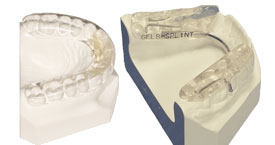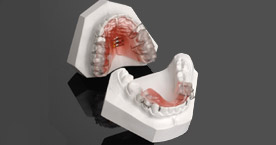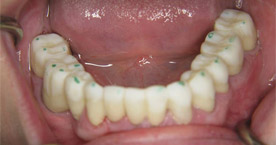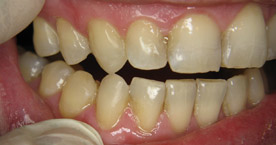The therapeutic aim is to have a stable jaw joints, supported by teeth in the appropriate relationship to the joints, decompressing the jaw joints and enhancing optimum function. This leads to relief of the symptoms (link) such as muscle pain, tension, headaches, neck aches and more. Decrease destructive forces on your teeth helping you to keep your natural teeth and restorations longer. Some patients even report improvements in back pain, hearing difficulties and dizziness. A comprehensive diagnosis and personal assessment by knowledgeable experts is the key to a successful outcome.
We do this by using case-specific, custom designed appliances to enable the jaw assembly to function properly with the disk in the correct place, while supporting the bite. Whether the appliance is fixed or removable, day time or night time, upper and/or lower, this will depend on your particular needs and condition. Your custom, therapeutic appliance will enable healing of the joints and proper functioning with reduction in pain. Once this has been achieved, we can then restore your bite optimally involving orthodontics, restorations or a combination of both depending on the specifics of your case.
Step 1: A comprehensive, diagnostic examination including manual stimulation of the head, neck and jaw muscles and evaluation of the airways, joints, bite and teeth.
Step 2: Report of condition and recommendations for treatment and symptom relief.
Step 3: Relax muscles and obtain customized record of optimal bite position.
Step 4: Custom fabricate and use specific and appropriate appliances to enable proper joint function and maintain the optimal bite position to enable healing to occur.
Step 5: Monitor healing process and stabilization to reach maximum medical improvement.
Step 6: Restore damaged teeth or unstable bite to maximum medical functionality.
Some therapeutic treatments include:
Jaw Repositioning Appliance(s)
Different from a regular mouth guard or night guard, a repositioning appliance teaches your body to hold your jaw joints in a more stable and healing position. These appliances (either an upper or lower or both) are worn for a period of 3, 6, or 12 months until a stable position is reached.
Stabilization Splint
 An upper or lower occlusal splint to increase the posterior vertical dimension and reduce functional forces on the temporomandibular (jaw) joints.
An upper or lower occlusal splint to increase the posterior vertical dimension and reduce functional forces on the temporomandibular (jaw) joints.
There is separation provided when you move your jaw from side to side and less damage can occur to the teeth. The muscles can relax as they are at a more proper length and your bite is supported.
Twin Blocks
 Twin Blocks are a removable functional appliance that consist of two bite blocks (twin blocks), upper and lower, which interlock in such a manner that the mandible is held in a more protrusive position and the condyle (jaw bone) is directed forward to a more centered position in the jaw sockets, allowing healing. The appliances are held comfortably in place with metal clasps and are made primarily out of a semi-clear acrylic to match the lining of the mouth. The two appliances are to be worn together 24 hours a day, 7 days a week and only removed for cleaning. These appliances have the added benefit of being able to correct malocclusion and arch width are relatively easy to speak with once you have adapted to them and are tolerated well.
Twin Blocks are a removable functional appliance that consist of two bite blocks (twin blocks), upper and lower, which interlock in such a manner that the mandible is held in a more protrusive position and the condyle (jaw bone) is directed forward to a more centered position in the jaw sockets, allowing healing. The appliances are held comfortably in place with metal clasps and are made primarily out of a semi-clear acrylic to match the lining of the mouth. The two appliances are to be worn together 24 hours a day, 7 days a week and only removed for cleaning. These appliances have the added benefit of being able to correct malocclusion and arch width are relatively easy to speak with once you have adapted to them and are tolerated well.
Read treatment detail (PDF)
Fixed Orthotic
 When a bite is overclosed and there are symptoms like muscle pain and jaw joint soreness, the first phase treatment is some kind of appliance to establish a new bite on a trial basis. This is frequently a stabilization splint as seen above. The trial period assists in both relief of symptoms as well as provides an opportunity to ascertain the ideal jaw and bite position for each patient.
When a bite is overclosed and there are symptoms like muscle pain and jaw joint soreness, the first phase treatment is some kind of appliance to establish a new bite on a trial basis. This is frequently a stabilization splint as seen above. The trial period assists in both relief of symptoms as well as provides an opportunity to ascertain the ideal jaw and bite position for each patient.
Once the splint therapy has been effective and the bite and jaws are stabilizing, it is often possible to complete a diagnostic wax-up of a proposed treatment position. The photograph shows blue wax on top of a lower jaw cast of the existing teeth and restorations representing the ideal conditions.
 The top surfaces of the existing teeth and restorations are abraded and the wax blueprint is converted to bonded composite material as shown in the second photograph. The bite is refined over several months after which the new stable relationship is converted into final crown and bridge rehabilitation.
The top surfaces of the existing teeth and restorations are abraded and the wax blueprint is converted to bonded composite material as shown in the second photograph. The bite is refined over several months after which the new stable relationship is converted into final crown and bridge rehabilitation.
Bite collapsed ortho (PDF)
Worn and collapsed bite (PDF)
Canine Risers
 When there is a lack of jaw separation and uncoordinated movement in sideways excursion, the canine can be reshaped and/or rebuilt with a riser to achieve an optimal jaw separation and movement pattern. This in turn will restore lost or worn tooth striction, reduce muscle tension and relieve posterior tooth interferences. A training riser is designed in tooth coloured composite and can later be replaced with bonded porcelain.
When there is a lack of jaw separation and uncoordinated movement in sideways excursion, the canine can be reshaped and/or rebuilt with a riser to achieve an optimal jaw separation and movement pattern. This in turn will restore lost or worn tooth striction, reduce muscle tension and relieve posterior tooth interferences. A training riser is designed in tooth coloured composite and can later be replaced with bonded porcelain.
Occlusal Harmonization
Reshaping of the contacting surfaces of the upper and lower teeth in order to allow for a more correct interdigitation and less stressful side to side movement with the teeth in contact.
 Finalization
Finalization
Depending on the complexity of each case, once the joints are stable further treatments may be recommended to maintain the stable and comfortable position of the joints. This can be done with long term solutions incorporating the above or with orthodontics or tooth coloured restorations like crowns and bridges.
Coordinated Care
 In addition to some of the above therapeutic solutions, we frequently refer patients to seek physiotherapy, massage therapy, chiropractic therapy, behavioural modification therapy, speech therapy and other related medical treatments to supplement their care with us. We may also suggest specialized dentistry with other experts in the field like periodontists, implant specialists and oral surgeons as needed. More information about the specific treatments that would benefit you will be provided after your comprehensive examination.
In addition to some of the above therapeutic solutions, we frequently refer patients to seek physiotherapy, massage therapy, chiropractic therapy, behavioural modification therapy, speech therapy and other related medical treatments to supplement their care with us. We may also suggest specialized dentistry with other experts in the field like periodontists, implant specialists and oral surgeons as needed. More information about the specific treatments that would benefit you will be provided after your comprehensive examination.



